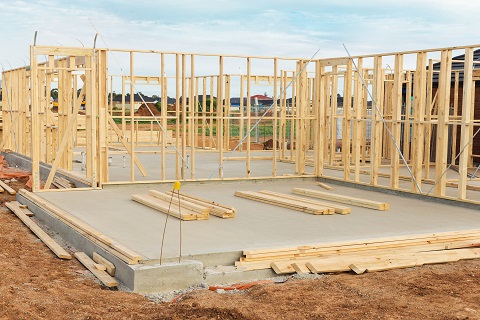People ask a lot of questions about home building, but they very rarely question the most important part of a house- the foundation. The foundation is literally what is holding up your home and maintaining its integrity. Every home is built on a foundation, but not every home is built on the same type of foundation.
The type of foundation most suited for a home depends on a few things such as geographical location, climate, soil, and house design to name a few. There are a few foundation options out there, but most homes have one of these three: basement foundation, crawlspace, or slab-on-grade. Each has their pros and cons, so here’s what you need to know before picking the right one for your custom home.
Basement Foundation
A basement foundation is the deepest of the three major foundation types. Typically a basement will mirror the floor space above, and is usually at least 6 feet high. Newer homes tend to put in full height basements that can be finished and converted into living space.
Pros:
The biggest benefit of a basement foundation is the extra space you gain. A finished basement not only adds square footage to a home, it also adds value. In Toronto, many homeowners convert their basements into rental properties for extra income. Basements also work great in colder climates like Canada. A basement foundation also provides easier access for repairs.
Cons:
The bad news about basements is that they can be expensive. In fact, they’re the most expensive out of the three most common foundation types. Basements can also have water issues, which could lead to damage or mold in the entire home. Since basements are deep underground, they are prone to moisture and flooding, which require additional equipment like sump pumps to combat this.
Crawlspace Foundation
A crawlspace foundation is a when a home is built on footings and surrounded by short foundation walls. This leaves a small gap between the ground and the bottom of the house, which is known as the crawlspace. This area is generally small, so small that you literally have to crawl to navigate it.
Pros:
A big pro of crawlspace foundations is they’re less expensive than basements to build because they require less excavation and foundation materials. Crawlspaces also provide access to utilities, even if one has to crawl to get to them.
Cons:
Like basements, crawlspaces can be prone to moisture too. Many people also find that small animals such as raccoons find their way into their crawlspace. This can cause further issues, especially if the animal dies there.
Slab-On-Grade Foundation
A slab-on-grade foundation (also simply called a concrete or slab foundation) is simple a solid concrete slab that rests on the ground. The slab part of the name refers to the concrete pad the home is built on, while grade refers to ground-level. This type of foundation isn’t as common in Canada because they work best in climates where the ground doesn’t freeze and thaw as this can lead to cracks in the foundation.
Pros:
Slab foundations are the least expensive foundation option, as they don’t require any excessive digging or materials. This foundation type is also the lowest maintenance. This makes them the ideal choice for people who don’t want the hassle of maintaining a basement or crawlspace.
Cons:
The bad news is that concrete foundations are recommended in Canada. The ground up here freezes and thaws through the seasons, which can cause the foundation to crack and shift. The other downside is that all of the utilities are encased in concrete, which means if there you need to repair something or change something you have to jackhammer into the foundation.
Conclusion
Hopefully, this information helped answer some questions you had about foundations. If you have any questions please feel free to ask us. Foundations are vital; after all, they’re what’s keeping your house up so it’s good to fully understand everything about them.





